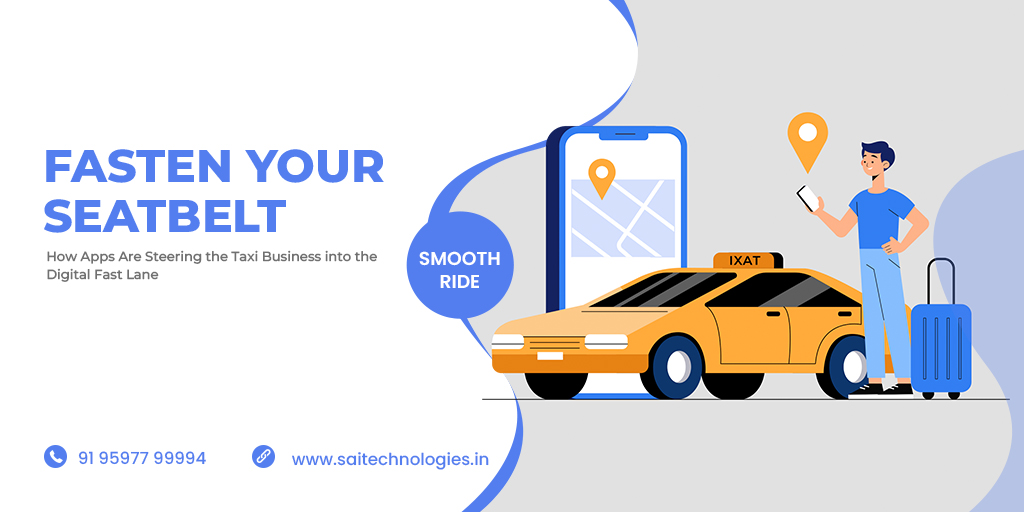Fasten Your Seatbelt
How Apps Are Steering the Taxi Business into the Digital Fast Lane

The taxi industry, once characterized by the iconic image of yellow cabs lining bustling city streets, is experiencing a profound transformation powered by the forces of digitalization. In this article, we embark on a journey through the dynamic landscape of the taxi business, exploring the pivotal role that mobile apps are playing in reshaping how we not only hail cabs but also revolutionize the entire taxi ecosystem. From enhancing convenience for passengers to improving efficiency for drivers, let's delve into the transformative impact of these apps as they accelerate the taxi industry into the digital fast lane.
The Traditional Taxi Landscape: A Nostalgic Journey
The Iconic Yellow Cab:
The vibrant image of yellow taxis navigating urban streets has long been a symbol of transportation convenience. Hailing a cab often involved standing on the curb, waving down a passing taxi, or waiting at designated taxi stands – a scene deeply ingrained in our collective memory.
Challenges in Convenience:
While emblematic of urban life, the traditional taxi system came with inherent limitations. These ranged from varying cab availability based on location and time of day, potential wait times during high-demand periods, to a lack of transparency in fare calculations. Passengers often found themselves uncertain about the final cost of their ride, leading to occasional surprises at the end of their journeys.
The Emergence of Taxi Apps: A Game-Changing Shift
The Rise of Ride-Hailing Platforms:
The digital transformation of the taxi industry gained momentum with the advent of ride-hailing platforms. Pioneered by trailblazers like Uber and Lyft, these apps harnessed the power of technology to connect passengers with nearby drivers. The concept of tapping a few buttons on a smartphone screen to summon a ride transformed how people hailed and experienced taxi services.
Seamless Booking and Payment:
The true game-changer was the seamlessness these apps introduced. Passengers could now use their smartphones to book rides, track the real-time location of their assigned driver, and even make secure payments through the app. This newfound ease eliminated the need for physical currency exchanges or card swipes in the back seat, revolutionizing the rider experience.
A Dual Revolution: Benefits for Passengers and Drivers
Passenger-Centric Features:
Ride-hailing apps focused on enhancing the passenger experience. Real-time tracking allowed riders to monitor their driver's approach, alleviating anxiety over estimated arrival times. Moreover, passengers could receive upfront fare estimates, eliminating any ambiguity surrounding the cost of their journey.
Driver Empowerment:
The impact extended to drivers as well. Flexible work arrangements offered by ride-hailing platforms provided a means for drivers to earn income on their terms, enhancing the appeal of becoming a rideshare driver. Additionally, these platforms introduced driver safety features, such as driver and passenger ratings, ensuring a secure and comfortable experience for both parties.
The Impact on Traditional Taxis: Adapting to Stay Relevant
Digital Adoption by Taxi Companies:
In response to the sweeping digital disruption, traditional taxi companies recognized the need to adapt to stay relevant. Many established taxi services launched their own apps to compete in the changing landscape. These apps not only enabled riders to book taxis conveniently but also incorporated features like fare estimation and driver tracking, reflecting the influence of digital transformation on traditional services.
Competition and Collaboration:
As the industry experienced shifts, some traditional taxi companies formed strategic partnerships with ride-hailing platforms. These collaborations allowed traditional taxis to access a wider customer base while retaining their local presence, resulting in an evolution of market dynamics that combined both competition and cooperation.
Innovations Beyond Ride-Hailing: Expanding Horizons
Micromobility Integration:
The realm of ride-hailing expanded beyond four-wheeled vehicles. Ride-hailing platforms ventured into micromobility solutions, offering options such as electric scooters and bikes. This diversification aimed to address urban mobility challenges, reduce traffic congestion, and provide eco-friendly alternatives for short-distance travel.
Autonomous Vehicle Testing:
The taxi industry emerged as a pioneering field for testing autonomous vehicles. Self-driving taxis hold the promise of transforming urban transportation by reducing accidents and congestion, optimizing routes, and offering a glimpse into the future of mobility.
Challenges and Roadblocks on the Digital Journey
Regulatory Hurdles:
The rapid rise of ride-hailing platforms was met with regulatory challenges in many regions. Concerns over passenger safety, fair competition, and the status of drivers as employees versus independent contractors sparked debates that underscored the need for adaptable regulatory frameworks.
Data Privacy Concerns:
The collection and utilization of user data by ride-hailing apps raised concerns about data privacy and security. As these platforms gathered vast amounts of personal information, addressing these concerns while maintaining the benefits of app-driven convenience proved to be a delicate balance.
The Future of Taxi Business: Navigating Forward
Electric and Eco-Friendly Taxis:
The growing emphasis on sustainability has prompted a shift towards electric and eco-friendly vehicles in the taxi industry. As cities implement stricter emissions regulations, adopting greener vehicles aligns with evolving consumer preferences and environmental goals.
Shared Mobility Solutions:
The concept of shared rides and pooling gained momentum, offering cost-effective options for passengers while contributing to reduced traffic congestion. This model presents a compelling solution for urban transportation challenges, particularly in densely populated areas.
Conclusion: A Digital Journey That's Changing the Ride
The taxi business is on an exhilarating digital journey that is fundamentally altering the way we move, connect, and experience urban transportation. The rise of ride-hailing apps marks a transformative shift from the traditional taxi model, propelling the industry into a future characterized by enhanced convenience, increased efficiency, and sustainability. From the iconic yellow cabs of the past to the app-summoned vehicles of today, the taxi industry is navigating the digital fast lane, steering us towards a dynamic and interconnected future of urban mobility. As we fasten our seatbelts for this digital ride, one thing remains clear – the taxi business is driving into the future with innovation at the wheel.


